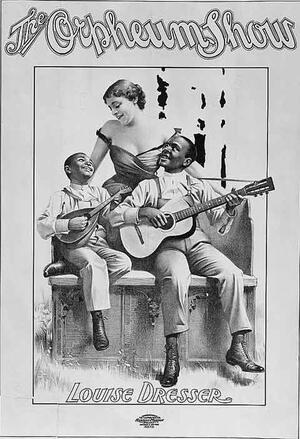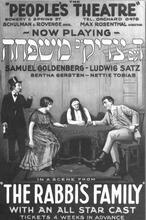Louise Dresser
From her stage name to her rumored marriage to actor Will Rogers, Louise Dresser manipulated markers of identity and status to her advantage throughout her career. The songwriter Paul Dresser allowed Louise Kerlin to adopt his name and his songs to give her career an early boost. The ruse was so successful that many believed her to be his sister. She was wildly successful in vaudeville, earning as much as $1,750 a week singing before turning to Broadway, where she starred in Matinee Idol from 1910 to 1912. She then went to Hollywood, playing Will Rogers’ wife in movies like State Fair in 1933 and David Harum in 1934. In the first Academy Awards in 1929, she was nominated for best actress for A Ship Comes In.
NOTE: It has come to our attention that Louise Dresser may not have been Jewish. We have been unable to verify definitively whether or not she was Jewish.
Article
Louise Dresser was a celebrated singer in vaudeville and musical comedy, as well as a star in early motion pictures. She adopted the stage name of Louise Dresser after the songwriter Paul Dresser, an acquaintance of her father, encouraged her to use his name as a strategy for her to gain greater recognition on stage. This ruse, along with several of Paul Dresser’s famous songs, indeed improved Dresser’s drawing power in vaudeville, and she was often believed to be the sister both of Paul Dresser and novelist Theodore Dreiser (Paul Dresser’s brother). Known largely for her rendition of Paul Dresser’s song “My Gal Sal,” she also sang his “On the Banks of the Wabash.”
Born Louise Josephine Kerlin to Ida and William Kerlin, Dresser turned to the stage at age fifteen or sixteen after the death of her father, a railroad engineer. In 1898, she married composer and actor Jack Norworth, and they performed together in vaudeville, where she reportedly earned $1,750 a week. In vaudeville, Louise Dresser, like many other white women, used African-American children—known on stage as “pickaninnies”—as a chorus of eccentric singers and dancers. For this vaudeville act, she was billed as Louise Dresser and her Picks.
Although Dresser’s vaudeville engagements with her “pickaninnies” were but a small part of her varied career, they are nevertheless quite significant in relation to the history of Jewish women on stage. The white women associated with “pickaninny” acts traditionally used some type of racial masquerade, such as heavy racial dialect in their songs or blackface makeup. This appropriation of blackness was particularly popular with Jewish actors, including such famous Jewish female performers as Sophie Tucker. Historians have noted that this racial borrowing helped Jewish performers establish an American identity. These racial disguises dramatized the remaking of ethnic identity but also reinforced derogatory stereotypes of African Americans. In this light, Dresser’s career reveals broader patterns of assimilation and exclusion in turn-of-the-century American culture.
After vaudeville, Louise Dresser found success on Broadway. She starred with De Wolf Hopper in Matinee Idol (1910–1912) and had roles in Broadway to Paris (1912), Potash and Perlmutter (1913), and Hello Broadway! (1914).
Following her divorce from Norworth in 1908, Dressler married actor Jack Gardner in 1910. This marriage lasted until Gardner died in 1950. Louise Dresser is perhaps best remembered for her roles in the many films in which she played the wife of Will Rogers, including State Fair (1933) and David Harum (1934). Dresser and Rogers were so closely linked in the minds of their fans that many believed they were actually husband and wife. Dresser also played Al Jolson’s mother in Mammy (1930) and had leading roles in The Goose Woman (1925) and The Scarlet Empress (1934). She retired from motion pictures in 1937, and although she planned a revival of her career following the death of her second husband, her comeback was not successful. Louise Dresser died in Woodland Hills, California, in 1965, following surgery for an intestinal obstruction.
Bordman, Gerald. Oxford Companion to American Theatre (1984).
DAB 7.
Dresser, Louise. Daniel Blum Collection. Clipping files. State Historical Society of Wisconsin, Madison, Wis..
Ewen, David, ed. American Popular Songs: From the Revolutionary War to the Present (1966).
Halliwell, Leslie. Filmgoer’s Companion. 4th ed. (1974).
Ireland, Norma Olin. Index to Women of the World from Anient to Modern Times (1970).
Katz, Ephraim. Film Encyclopedia (1979).
“Louise Dresser.” NYTimes, April 25, 1965, 87:3.
“Louise Dresser.” Variety, April 28, 1965.
Ragan, David. Who’s Who in Hollywood (1992), and Who’s Who in Hollywood, 1900–1976 (1976).
Samuels, Charles, and Louise Samuels. Once Upon a Stage—The Merry World of Vaudeville (1974).
Schuster, Mel. Motion Picture Performers: A Bibliography of Magazine and Periodical Articles, 1900–1969 (1971).
Slide, Anthony. “Louise Dresser.” Encyclopedia of Vaudeville (1994).
Springer, John, and Jack Hamilton. They Had Faces Then: Super Stars, Stars and Starlets of the 1930s (1974).
Truitt, Evelyn Mack. Who Was Who on Screen. 3rd ed. (1983).
WWWIA 4, 7.




